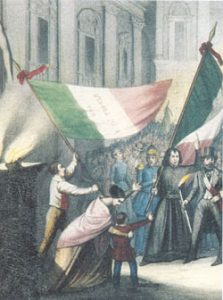Historical background
The origins of the Library of Modern and Contemporary History date back to June 1880.
The history
The origins of the Modern and Contemporary History Library date back to June 1880, when the Chamber of Deputies approved Pasquale Villari’s proposal to establish a collection of books, pamphlets and documents relating to the Italian Risorgimento. Thus the Risorgimento Section of the Vittorio Emanuele II National Library in Rome was born, whose director, Domenico Gnoli, began the work of acquiring the original nucleus of the collections through a dense network of relationships with antiquarian bookshops and with the protagonists of the Risorgimento events themselves, or their descendants.
In 1906, on the initiative of the Minister of Education, Paolo Boselli, with Royal Decree No. 212 of 17 May 1906, the National Committee for the History of the Risorgimento was established with the task of setting up a library and museum of the Risorgimento, which was to be housed in the monument dedicated to King Victor Emmanuel II on the Capitoline Hill. The Committee was entrusted with the Risorgimento Section, which, according to the provisions of Royal Decree No. 730 of 22 November 1906, was to remain in the care of the director of the National Library in the premises of the former Roman Jesuit College until the construction of the monument was completed. The Committee was set up in 1909 and in the following years continued a vast policy of acquiring Risorgimento materials that expanded and enriched the collections.
 With the outbreak of the World War, the Committee was committed to finding all sorts of bibliographic and documentary evidence on the war, considered in those years the crowning achievement of the national Risorgimento. In 1917, with Royal Decree no. 336 of 15 February 1917, the Risorgimento Section took the name of Central Library of the Risorgimento, assuming the physiognomy of an autonomous library under its own conservator.
With the outbreak of the World War, the Committee was committed to finding all sorts of bibliographic and documentary evidence on the war, considered in those years the crowning achievement of the national Risorgimento. In 1917, with Royal Decree no. 336 of 15 February 1917, the Risorgimento Section took the name of Central Library of the Risorgimento, assuming the physiognomy of an autonomous library under its own conservator.
The definitive separation from the National Library was sanctioned in 1921 with the transfer of the collections to Palazzetto Venezia, while waiting for the premises of the Vittoriano to be ready. With Royal Decree no. 9320 of 27 September 1923, the name was again changed to Biblioteca Museo Archivio del Risorgimento, and with the subsequent Royal Decree no. 1821 of 23 October 1924, it was established that it would be headed by a conservator-conservator belonging to the role of librarians and directly dependent on the Ministry of Education.
In the 1930s, a number of measures profoundly changed the character of the Library. Royal Decree no. 1226 of 20 July 1934, on the reorganisation of historical institutes, abolished the National Committee for the History of the Risorgimento and entrusted the museum collection to the National Society for the History of the Risorgimento, while the Library was placed under the supervision of a newly established body, the Italian Historical Institute for Modern and Contemporary Ages. In the years 1937-1938 the Risorgimento collection was dismembered: the bibliographic materials remained with the Library, while the museum materials and part of the documentary materials were handed over to the Institute, based at the Vittoriano. With Royal Decree no. 2181 of 22 November 1937, the Library took its present name of Library of Modern and Contemporary History and in 1939, as the last act in this complex affair, it moved to Palazzo Mattei di Giove, where it is still located today.
 From an institutional point of view, with Legislative Decree no. 356 of 12 April 1945, the Library was placed under the direct authority of the Ministry of Public Education, then, since 1975, of the Ministry of Cultural and Environmental Heritage, which became the Ministry of Culture in 2021, through numerous institutional steps. As far as the Library’s purposes are concerned, until the 1950s, it remained mainly linked to Risorgimento studies, while, from the 1960s onwards, it broadened its field of interest to 19th and 20th century Italian and European history.
From an institutional point of view, with Legislative Decree no. 356 of 12 April 1945, the Library was placed under the direct authority of the Ministry of Public Education, then, since 1975, of the Ministry of Cultural and Environmental Heritage, which became the Ministry of Culture in 2021, through numerous institutional steps. As far as the Library’s purposes are concerned, until the 1950s, it remained mainly linked to Risorgimento studies, while, from the 1960s onwards, it broadened its field of interest to 19th and 20th century Italian and European history.
Current orientations tend to provide basic tools for the study of the history of Italy and other countries in the 16th-20th centuries, with a focus on the 19th and 20th centuries. Particular attention is paid to the integration of original documentation, especially the collections of 19th and 20th century periodicals
